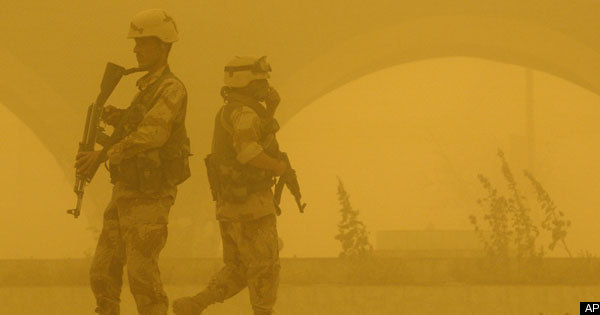Corbon .38 Super Ammunition Tests
By Stephen Camp
As mentioned in an earlier piece comparing the .38 Super to 9x19mm, most commercially available loads are little if any hotter than 9mm +P. About the only advantage I can see is that a near identical ballistic delivery is achieved with less pressure using the Super. Winchester's 125-gr. Silvertip hollow point in Super chronographs no hotter than similar loads in 9mm, but the 9mm is at the top of its +P or +P+ pressure capabilities while the Super is not.
In the past I hotrodded 115-gr. Sierra JHP's to velocities in the 1300 to 1400 ft/sec range and fired more than a few through an old Colt Government Model that had been customized and fitted with a BarSto barrel and bushing by gunsmith, Lou Williamson. The factory barrel was the older design, which tried to headspace on the Super's semi-rim and describing accuracy as "lackluster" would be a compliment! With the fitted BarSto, which headspaces off of the case mouth just like .45 ACP, the same loads that produced 10" diameter "patterns" at 25 yards, now produced groups the size of a poker chip at the same distance.
The rapid-expanding JHP handloads were graphically effective on jackrabbits and other such critters and did a good job on coyotes as well.
I've made many mistakes in my life and one of the biggest was selling that gun, at least 10 extra magazines, accompanying reloading equipment, and ammunition to a good friend. He still has that old gun and will not sell it back!
For several years I was without a .38 Super, but rectified that by purchasing a 5" STI Trojan a few years ago. Like the BarSto-fitted Colt, the STI match grade barrel headspaces off of the case mouth and the gun has proven to shoot most .38 Super handloads with very fine accuracy. Likewise, it is has performed well with several boxes of factory ammunition, but due to factory ammunition costs my Super normally gets fed handloaded fodder.
In this caliber I am currently shooting but two loads. One is a ball-replicating 125-gr. handload at about 1200 ft/sec while the other uses either a Hornady 147-gr. XTP or Remington Golden Saber in the same weight. These are driven to just under 1200 ft/sec from the Trojan's 5" barrel. True enough, this is faster than the velocity envelope for which these bullets were designed, but the bullets have performed quite satisfactorily on Texas whitetail deer and a few varmints.
For those interested in these loads, here's a link to more information:
http://www.hipowersandhandguns.com/38SuperTo9mm.htm
In the future I'll probably try handloading the 115 and 125-gr. JHP's to higher velocities as I did a couple of decades ago.
In the meantime, I want to take a look at some of the faster .38 Super ammunition on the market. It is from Corbon, and bullet weights range from 80 to 125 grains.
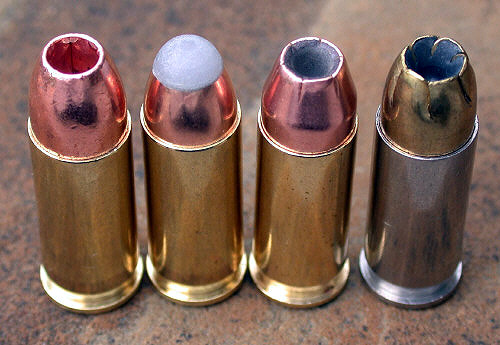
From left to right: Corbon .38 Super 125-gr. DPX +P, Corbon 100-gr. PowRball +P, Corbon 125-gr. JHP +P and a handloaded Remington 147-gr. Golden Saber. We'll also take a look at the 80-gr. Glaser Safety Slugs (Blue & Silver) offered in this caliber though they are not pictured. (Externally, the Glaser Silver looks almost identical to the Pow'RBall shown. The Glaser Blue does as well, but has a blue nose plug. The Glaser and Pow'RBall may resemble each other, but they have dissimilar expansion characteristics.)
The firearm used in these tests was this STI .38 Super with a 5" barrel.
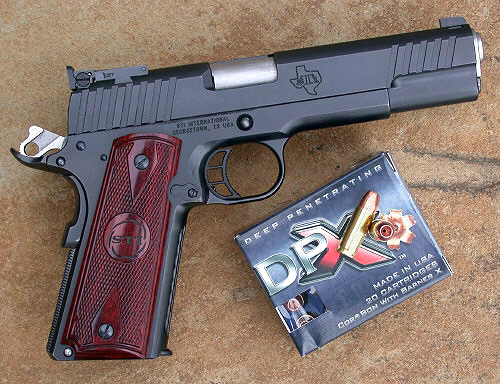
The test gun is shown here with a box of the 125-gr. DPX ammunition.
Shooting: Shooting was done at distances of 15 and 25 yards. It was done using a two-handed hold with my wrists supported while seated. There was no effort made at "practical" type shooting. I simply wanted to see if the ammunition would group. If I miss, I want to know that I missed and not the gun/ammo combination.
The exception to shooting at 25 yards was the Glaser. I simply didn't have enough of this ammunition to shoot at that distance and complete the chronograph and expansion testing I wanted to do. It was fired only at 15 yards.
Here are some selected targets.
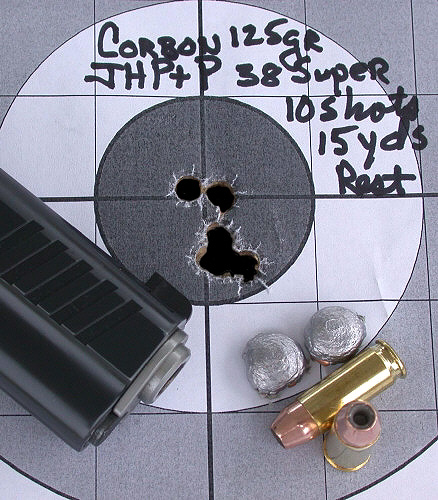
Here we see that Corbon's 125-gr. JHP +P groups well. It expands aggressively when fired into super-saturated newsprint. These bullets do sometimes fragment not only in test media, but in animal tissue as is evidenced by recovered 115-gr. Sierra PJHP bullets taken from coyotes. I have not shot anything with Corbon's 125-gr. JHP +P, but expect similar performance since Sierra makes the bullet used in this load. The 100-gr. Pow'RBall grouped almost identically at this distance and was on par with the DPX ammo at 25 yards.
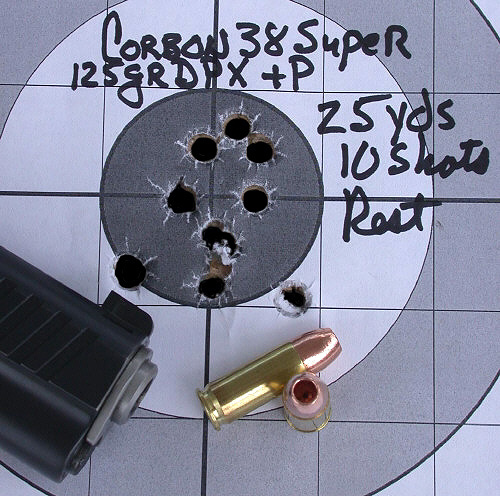
Corbon's 125-gr. DPX +P grouped nicely at 25 yards. Both their 100-gr. PowRball and 125-gr. JHP+P grouped just as well. The POI for the Pow'RBall was slightly lower, but not by as much as expected. For my eye and my hold, it seemed to hit about 2 to 3" lower at this distance.
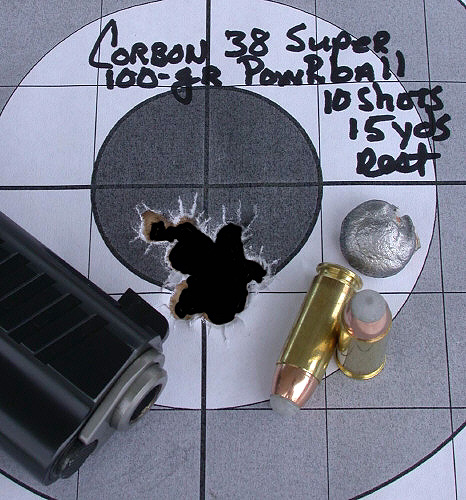
At both 15 and 25 yards, Pow'RBall showed itself a very capable performer from the STI with regard to accuracy. The expanded Pow'RBall bullet was recovered from super-saturated newsprint. Expansion characteristics of all of the Corbon .38 Super ammunition fired will be discussed later.
I could not do any 50-yard shooting due to that range being used by several others, but I do believe that this ammunition is capable of producing plenty good accuracy at that distance if the shooter is. In any event, all of the ammunition proved capable of nice groups from the STI.
For those remembering sometimes-mediocre accuracy with early Glaser Safety Slugs, that has long since been corrected. The lead shot used for the core of this pre-fragmented bullet is now compressed into a more solid core. Bullet weight is much more uniform and I've seen it produce very good accuracy in both 9mm and .38 Super.
Bullet Differences in Corbon's .38 Super Ammunition: Very different bullets are used in Corbon's different lines of ammunition, so let's take a look at each, their characteristics, and how they work.
Glaser Safety Slug: Invented over 30 years ago, the Safety Slug has gone through some significant changes. Though it still remains a pre-fragmented bullet, steps have been taken to make this specialty round more consistent bullet-to-bullet and more accurate. The bullet profile is that of a jacketed round nose to insure feed reliability in a wide number of pistols. The shot pellets are no longer "loose" within the jacket. Instead, they are tightly compressed. The compressed lead shot mimics a solid lead core bullet. Instead of what would be lead on a jacketed soft point, the Glaser has a polymer tip instead. The Safety Slug has a skived jacket to help insure that it literally shreds itself in "soft targets."
There are two types of Safety Slugs at the present time. One is called Glaser Blue and the other, Glaser Silver. The blues have a blue nose plug while the silvers have one that is gray. The nominal velocity on either is listed at 1700 ft/sec from a 5" barrel. The Glaser Blue uses #12 shot and is reported to penetrate between 5 and 7" of 10% ballistic gelatin after passing through 4 layers of denim. Glaser Silver uses larger #6 shot and penetrates 8 to 10" in ballistic gelatin using the same protocol as Glaser Blue.
In the calibers for which the Safety Slug is offered, bullets are light for that caliber and driven to extremely high velocities. Many, but not all, have +P designations. Both the Blue and Silver in .38 Super designated +P.
The idea is that the Glaser Safety Slug begins to deform and come apart shortly after penetration begins in tissue. The bullet's rapid deformation might better be referred to as disintegration as the bullet jacket shreds itself and shot begins to tear a myriad of small wound channels. In ballistic gelatin, the temporary cavity produced by the Safety Slug looks similar to the profile of an onion; it's more "ball shaped" than is produced by most expanding bullets.
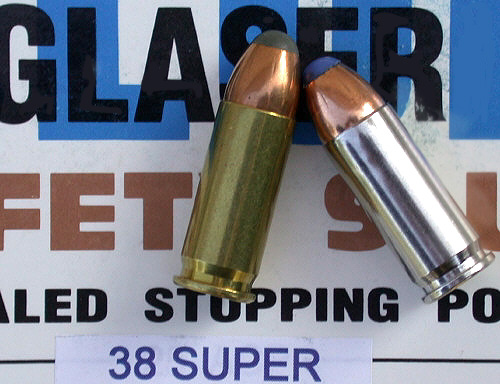
Shown on the left is the Glaser Silver and next to it is a Glaser Blue. The different colored polymer nose plugs indicate different shot sizes. I have no idea why one uses a nickel-plated case and the other does not, but noted no difference in reliability.
The Glaser is designed not to completely penetrate a human being, assuming a decent torso hit. It also has less ricochet potential than most other bullets. Unless striking a hard surface at a very shallow angle, this stuff just self-destructs. It is probably less likely to penetrate apartment walls as a single 80-gr. projectile, thus reducing danger to innocents in the event of an errant shot.
In the past, great claims have been made concerning the Glaser's "stopping power" potential. These days, opinions are mixed. Some believe that its high velocity and rapid "energy dump" contributes to a very effective round. Others express concerns about too little penetration. I think that the truth lies somewhere in between.
I have no actual first-hand experience with the Glaser on human beings nor have I visited with anyone who has. I have shot a number of small animals and two coyotes with the Glaser Blue. (The Silver did not exist at the time that I shot these animals.) On rabbits, raccoons and coyotes, I found the 9mm Glaser to be effective, graphically so in some instances. On the smaller animals, larger-than-normal entrance wounds were readily visible and it was not unusual to see hemorrhaging from about every body orifice. The one coyote I hit with it was while varmint calling and he was shot directly behind the shoulder at about 15 yards. He simply collapsed and kicked his hind legs a few seconds.
The only other coyote I killed with this load was while in police service. One had been hit by a car but was still alive. It was sitting up on its hind legs but its back must have been broken as it could only drag itself along with its front legs. This was in the wee hours of the morning. When my duty-bound-follow-the-rules call for animal control to come and dispatch the animal took more than a half-hour, I used a 9mm Glaser from my Browning to put a humane end to this animal, deciding to "take the heat" rather than let it suffer. I eased behind the animal and from about 6' shot it in the back of the head with a Glaser Blue. (I'd removed the more conventional JHP and used the Blue to limit penetration as much as possible since I was within the city and in front of an apartment complex. At the shot, the animal just fell over. Its eyes were blown out of the sockets so I believe that the brain was probably pulped and the rapid expansion of liquid and semi-liquid tissue created a significant pressure peak in the animal's skull.
So how does this equate to stopping a grown man determined to kill you? I am not sure. I think that with a straight and unobstructed center chest hit, the Glaser would be effective. I have no way to know if it would be more or less effective than an expanding hollow point given the same hit, but I do believe that one would not have overpenetration concerns.
On the other hand, the Glaser might very well give up a good deal of its effectiveness if it had to pass through an arm on the way to the torso! For this reason, the Safety Slug is not my first choice in ammunition for self-protection. Were I going to use the Glaser, I believe I'd go with the Silver whenever possible.
Jacketed Hollow Point: Corbon has two JHP loads in .38 Super and both are +P. They use the very aggressively expanding Sierra Power Jacket Hollow Point in 115 and 125 grains. They are rated at 1425 and 1325 ft/sec, respectively and the bullets are available from Sierra for handloaders.
I have used Sierra hollow points from the time that they were called Jacketed Hollow Cavity bullets, through their change to hollow point and to this final version, which has been available for several years. These bullets have large hollow cavities, blunt noses, and skived jackets.
I've used Sierra PJHP bullets in several calibers, but have probably fired more of it in 9x19mm than any other. Both the 115 and 125-gr. PJHP bullets have proven themselves capable of very good accuracy and at Corbon's velocities, they will expand violently in soft targets. In my observation, they are also likely to have some fragmentation. Jacket separation from the expanded lead core is not unusual.
In .38 Super I'd expect the faster 115-gr. PJHP to penetrate between about 10 to 12" and about the same for the 125-gr. version. These are such rapid-expanders that I've seen nearly identical penetration for both versions in either super-saturated newsprint or water. On animals, I can tell no difference.
Once again, the main concerns expressed by some with this ammunition is lack of penetration. I'm not sure how valid these complaints are, but they're certainly there.
I know one man who has used the 9mm Corbon 115-gr. JHP +P on two men. His pistol was a Glock 19. One man was double-tapped in the chest and dropped, never to stand again while the other was hit in the head. I would expect the Super to have done as well or maybe better, but can only guess since shootings with this caliber are just not that common.
My friend (the one who won't sell the Colt back to me) has cleanly taken a few Texas whitetail deer with it over the years. One was very close when he shot it in the head. He mentioned that the eyes left the sockets in this instance too. Another close range broadside shot got him a nice doe. At the hit, she fell and kicked a few seconds and was gone. The bullet did not exit.
To me, the main area for concern with this JHP is its shape. Some guns simply will not feed them reliably due to their blunt ogive and correspondingly shorter cartridge LOA. Others gobble them up as smoothly as FMJ rounds.
If a person wants a low to moderate-penetration and aggressively expanding load in Super, these would be the place to look. A benefit for reloaders might be using Sierra's exact same bullet to construct practice ammunition loaded to around the same speeds as the factory Corbon ammunition.
Though I prefer just a bit more penetration, I would not feel ill at ease using Corbon's JHP ammo in either 9mm or .38 Super. I'd probably opt for the 125-gr. version even though I'm not convinced that it penetrates significantly deeper than the 10-grain lighter bullet.
Pow'RBall: This is a relatively new design, but one that predates Corbon's DPX line of ammunition. The Pow'RBall was developed to insure reliable feeding, something that could be a problem with the Corbon JHP ammunition. If a pistol will feed ball, it should feed Pow'RBall.
These bullets will be light for caliber. I suspect this is due to the polymer nose plug. The volume it occupies would be of much heavier lead in a conventional bullet. These jacketed, lead core bullets resemble the Glaser Safety Slug externally.
Pow'RBall has a massive, wide V-shaped hollow cavity which is covered by a gray-colored polymer nose plug. It does not clog with material when penetrating the 4-layers-of-denim protocol and is designed to penetrate at least the FBI-mandated 12" of ballistic gelatin. My STI Trojan in .38 Super is a picky feeder when using blunt-nosed expanding ammunition. It feeds Pow'RBall without any problems whatsoever.
I have not seen Pow'RBall used on any animals so I can offer nothing there, but in various media I've shot, it has consistently expanded aggressively and penetrated deeper in super-saturated newsprint than with the JHP's. This proved true with the .38 Super as well.

As you can see, Pow'RBall closely resembles the Glaser Safety Slug externally. Internally it is entirely different.
DPX: This is the newest line of Corbon ammunition and it's available in many calibers. In .38 Super, the solid copper bullet weighs 125-gr. DPX stands for Deep Penetrating X-bullet. Barnes makes the X-bullet, a version of which has long been familiar to rifle hunters. In the rifle version, the bullet expands via four "petals" creating an "X". The pistol ammunition expands using 6 petals.
Characteristics of the X-bullet include penetration greater than that normally associated with a conventional bullet of the same weight. There is also no jacket/core separation and the reason is simple; there is no jacket to separate! In pistol calibers, DPX has also proven itself to be a very, very consistent expander whether striking bare gelatin, or having to punch denim, sheet steel, or other barriers before impacting the gelatin.
Because copper is much less dense than lead, X-bullets will normally be lighter than traditional bullet weights in a given caliber, but can sometimes get to at least the low end of these weights depending upon the caliber and case capacity. With the .38 Super, this has been the case and the bullet weighs 125 grains. In .45 ACP, about the heaviest is 185-gr.
It should also be noted that DPX is not necessarily loaded to the highest possible velocities. It is loaded to velocities resulting in best bullet performance.
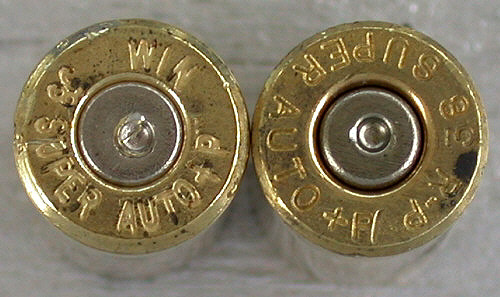
The more flattened primer on the left is from Corbon's 125-gr. JHP +P. On the right we see the primer from the Corbon DPX, which does not exhibit the same flattening. I have no idea why one load uses Winchester cases and the other, Remington.
I've tried Corbon's DPX in several calibers. In my own informal expansion tests, they have definitely proven consistent expanders. They have also proven very accurate.
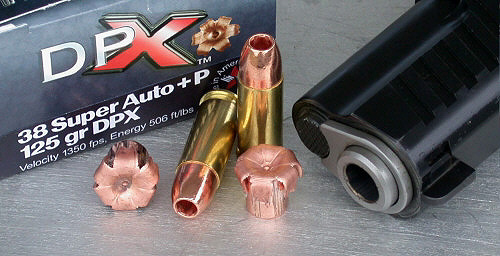
Here is the .38 Super DPX. Shown with the loaded cartridges are two of the five recovered bullets that were fired into super-saturated newsprint. These two are the most dissimilar of the bunch. You can see that the X-bullet reacts very uniformly. The .38 Super DPX has a rounded bullet ogive similar to the Remington JHP, but a wider hollow cavity, which makes it more blunt. Still, it should be a reliable feeder in most .38 Super pistols.
Chronograph Results: Ten rounds of each load were fired with the muzzle of the pistol 10' from the chronograph screens.
Corbon .38 Super Chronograph Results (ft/sec):
| Load: | Average Velocity: | Extreme Spread: | Std. Deviation: |
| Glaser Blue 80-gr. | 1682 | 28 | 13 |
| Glaser Silver 80-gr. | 1729 | 31 | 12 |
| Pow'RBall 100-gr. | 1529 | 34 | 12 |
| 125-gr. JHP | 1372 | 26 | 10 |
| 125-gr. DPX | 1313 | 23 | 9 |
As can be readily seen, each of these loads was consistent in velocity. It would take a machine rest to determine which is actually the most accurate and that would be absolutely meaningful only for the test gun. Another STI Trojan might very well prefer a different load, but at least in my hands, any of these possess inherent grouping capabilities beyond my skill level.
Expansion and Penetration Comparisons: 5 rounds of each load were fired into a stack of super-saturated newsprint. I cannot say that "my" way of preparing it is the best, but it is the method I use in all my informal penetration and expansion testing. It does not allow as deep of penetration as 10% ballistic gelatin, but in other calibers, the bullets recovered from it have been quite similar to those recovered from animals.
The muzzle of the gun was about 3' from the newsprint. Figures given are the averages of all five rounds individual weights, expanded dimensions, and penetration depths.
Corbon .38 Super Penetration (in.), Expansion (in.) & Recovered Weight (gr.)
| Load: | Penetration: | Expansion: | Weight: |
| Glaser Blue 80-gr. | 4.00 | N/A fragmented | N/A* |
| Glaser Silver 80-gr. | 4.50 | N/A fragmented | N/A* |
| Pow'RBall 100-gr. | 8.50 | 0.603x0.570x0.303" tall | 83.7 |
| 125-gr. JHP | 7.00 | 0.555x0.546x0.276"tall | 88.1** |
| 125-gr. DPX | 9.75 | 0.509x0.521x0.487"tall*** | 124.9 |
*Bits of bullet jacket were recovered, but different sizes for each shot fired. Likewise, pellets were found throughout the "wound track" after about the initial inch of penetration.
**Bits of lead and small portions of bullet jacket were found throughout the JHP bullets' "wound tracts."
***The petals on the DPX were folded rearward and the dimensions given are the recovered average of all five shots. At some point in the DPX bullet expansion, the petals were more extended and for at least that portion of penetration, the wound channel in tissue would likely have been of greater diameter. The bullet may have weighed 124.9 grains before shooting. I don't know, but none of the five rounds fired lost any measurable bullet weight.
In less dense 10% ballistic gelatin, the .38 Super DPX reportedly penetrates about 17" after passing through 4 layers of denim and the petals do not fold rearward as much as they do in my "wetpack" tests.
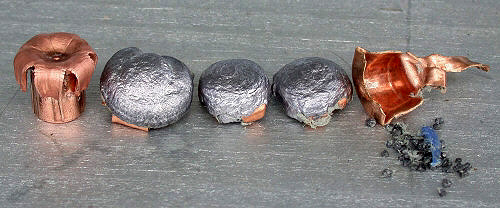
From left to right: 125-gr. DPX, 100-gr. Pow'RBall, two 125-gr. JHP's, Glaser Blue Safety Slug. One DPX and Pow'RBall bullet are shown because the other four of each were very close. The two JHP's were shown to also show that while pretty consistent in expansion characteristics, bullet fragmentation is evident along the edges. Some believe this is good while others do not. The one Glaser Blue was the least damaged of the five fired. Gathering the shot pellets shown was somewhat tedious and is not all of them. Some were loose in the wetpack "wound tract" while others were stuck a fraction of an inch in the newsprint beyond. This is why I made no effort at weighing them. 80 grains of Safety Slug went in and it's designed to fragment so 80 grains is inside the target, but recovered bullet weight would be meaningless.
Observations: In my all-steel 5" 1911 pattern pistol, none of the loads possessed significant recoil, but the Glaser Safety Slugs "kicked" least of all. I really didn't notice any differences between the rest of the loads fired. Mathematically, they were present, but I couldn't feel them.
There were no malfunctions or failures with the pistol or any of the rounds fired.
So, which is best? For my particular pistol, I 'd go with the Pow'RBall because it fed the smoothest of the rounds designed to expand but not self-destruct as did the Glasers. If my Trojan in .38 Super fed as smoothly as my Hi Powers or Trojan 9mm, I'd go with the DPX. That said, I do believe that there is a possibility of the .38 Super DPX completely penetrating an adult human torso in an unobstructed frontal chest shot. It is also most likely to perform uniformly even if punching windshields, thin sheet steel or other barriers before impacting the target from what others testing it report. Law enforcement personnel and some private citizens in high-risk occupations involving vehicles might strongly prefer DPX in this caliber.
I believe that any of these loads would prove effective against a non-barricaded felon with a solid chest hit and no obstructions, but in a life-or-death situation, such might not present itself. If a person wanted to find a load "in the middle", I'd once again go with Pow'RBall. I don't think overpenetration is of much concern with this round, but it penetrated a bit more deeply than the JHP's weighing 25 grains more.
If fears of overpenetration were an overriding concern, I'd go with the JHP's. I personally believe that the Safety Slugs just provide too little penetration for anything other than a straight-on frontal shot where no obstructions are guaranteed. Such conditions probably cannot be guaranteed.
Of the commercially available .38 Super ammunition I've seen, the most potent are almost certainly among these.
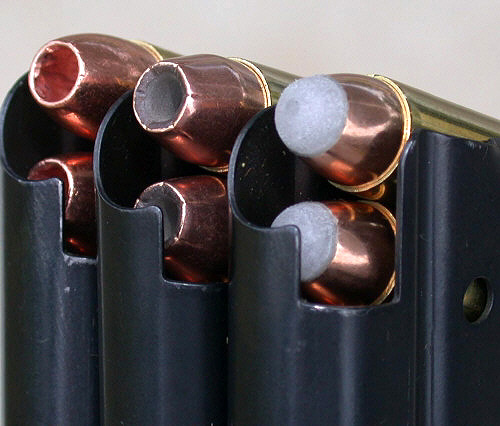
Assuming a reliable automatic, I wouldn't be too concerned if my gun was loaded with DPX, JHP, or Pow'RBall.
I sure wish my buddy would sell me back that old Colt.
........................................................................................................................................................................









